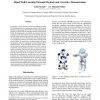Free Online Productivity Tools
i2Speak
i2Symbol
i2OCR
iTex2Img
iWeb2Print
iWeb2Shot
i2Type
iPdf2Split
iPdf2Merge
i2Bopomofo
i2Arabic
i2Style
i2Image
i2PDF
iLatex2Rtf
Sci2ools
AAAI
2010
2010
Biped Walk Learning Through Playback and Corrective Demonstration
Developing a robust, flexible, closed-loop walking algorithm for a humanoid robot is a challenging task due to the complex dynamics of the general biped walk. Common analytical approaches to biped walk use simplified models of the physical reality. Such approaches are partially successful as they lead to failures of the robot walk in terms of unavoidable falls. Instead of further refining the analytical models, in this work we investigate the use of human corrective demonstrations, as we realize that a human can visually detect when the robot may be falling. We contribute a two-phase biped walk learning approach, which we experiment on the Aldebaran NAO humanoid robot. In the first phase, the robot walks following an analytical simplified walk algorithm, which is used as a black box, and we identify and save a walk cycle as joint motion commands. We then show how the robot can repeatedly and successfully play back the recorded motion cycle, even if in open-loop. In the second phase, w...
| Added | 06 Dec 2010 |
| Updated | 06 Dec 2010 |
| Type | Conference |
| Year | 2010 |
| Where | AAAI |
| Authors | Çetin Meriçli, Manuela M. Veloso |
Comments (0)

